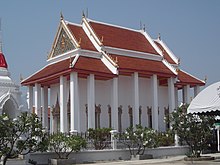| Wat Paramaiyikawat | |
|---|---|
 Ordination hall of temple Ordination hall of temple | |
| Religion | |
| Affiliation | Buddhism |
| Sect | Theravāda, Mahā Nikāya |
| Region | central Thailand |
| Location | |
| Location | 51 Moo 7, Ko Kret, Pak Kret, Nonthaburi |
| Country | Thailand |
 | |
| Geographic coordinates | 13°54′45.55″N 100°29′22.88″E / 13.9126528°N 100.4896889°E / 13.9126528; 100.4896889 |
| Architecture | |
| Founder | Mon people |
Wat Paramaiyikawat Warawihan (Thai: วัดปรมัยยิกาวาส วรวิหาร) or simple known as Wat Paramaiyikawat (วัดปรมัยยิกาวาส) is an ancient Buddhist temple located on Ko Kret, Nonthaburi Province, central Thailand rim Chao Phraya River.
The temple is classified as the second rank of royal temple. It is believed that it was built in the late Ayutthaya period after begin of Ko Kret. At that time it was called "Wat Pak Ao" (วัดปากอ่าว), which means "estuary temple" according to the location.
In 1764, when the Burmese occupied the city during the fall of Ayutthaya. The temple was left empty, until 1774 when the Mons immigrated in the King Taksin's reign who ordered to restore the temple which Mons call "Pia Moo Kia Terng" (เภี่ยมู้เกี้ยเติ้ง), which means "temple at the cape". In 1874, King Chulalongkorn (Rama V) presided over the Thot Kathin (ทอดกฐิน) ceremony in total four Mon's temples of Nonthaburi. Noticing that the temple is in utterly poor condition, the King ordered the restoration and overhaul of the temple by preserving the Mon's style in order to devote the merit to his grandmother (Princess Sudarattanarachaprayur ) who had raised him when he was young and named the temple "Wat Paramaiyikawat" like today, which means "temple of grandmother".
Interior ordinational hall features mural paintings in applied Thai traditional style and the doors with windows are decorated in coloured stucco style. Outside the temple at the rightmost of the island corner is the location of the "Phra Chedi Mutao" (พระเจดีย์มุเตา), a white pagoda in Mon's style. King Chulalongkorn once was here to pour relics of Buddha inside in 1884. This pagoda has a distinctive feature, it is a leaning pagoda.

Originally, it was an upright pagoda. Later on, water eroded the bank therefore causing the pagoda to tilt about the year 1891, despite efforts to restore it in 1992, it was unsuccessful. The pagoda is replica of the Shwemawdaw Pagoda of Bago, Myanmar which is a pagoda that is worshiped and highly respected by the Mons.
Presently, the leaning pagoda regarded as the symbol and landmark of Ko Kret. It is very beautiful when viewed from the midstream or from a boat that passes through because its location is the confluence of waterways Chao Phraya and Lat-Kret with Om-Kret. Both pagoda and temple has been registered as national ancient monuments by the Fine Arts Department since 1935.
Wat Paramaiyikawat also regarded as the gateway of Ko Kret because it has a ferry pier opposite the mainland of Nonthaburi (Pak Kret) which is a very popular route.
References
- "วัดปรมัยยิกาวาส" [Wat Paramaiyikawat]. Thailand Tourism Directory (in Thai). Retrieved 2019-05-30.
- ^ Lung Boran (2018-09-10). ""เจดีย์เอียง" วัดปรมัยยิกาวาส เกาะเกร็ด เมื่อยังไม่เอียง" ["Tilt Pagoda", Wat Paramaiyikawat, Ko Kret when not tilted]. Silpa-mag (in Thai). Retrieved 2019-05-30.
- "เกาะเกร็ด" [Ko Kret]. touronthai (in Thai). Retrieved 2019-05-30.
- "นั่งเรือข้ามฝาก "เที่ยวเกาะเกร็ด" เดินตลาดรอบเกาะ เที่ยวชมธรรมชาติใกล้เมืองหลวงแค่ไม่กี่กิโล" [Take a ferry "Ko Kret travel" around the island to visit the nature near the capital just a few km]. CheckInChill (in Thai). 2017-08-02. Retrieved 2019-05-30.
